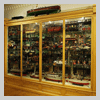
|
Every collector has a different opinion as to the best method of displaying their collection. There are two principal considerations. a. To protect from dust, ultra violet light, excess humidity, etc. The optimum method of achieving the first objective, namely to conserve your collection, will vary from one climate to another. However, in broad principle one should aim to achieve small temperature and humidity swings and absolutely to avoid sunlight and ultra violet light. The latter particularly on lithographed toys can quickly lead to disastrous fading. Dust can largely be controlled by the collection being displayed in glass fronted cabinets. Thus the ideal is to have a display area with temperature and humidity control and controlled lighting. Ultra violet filters in the form of an invisible film are readily available for windows. Artificial lighting in your collection room should be ultra violet free and lighting within the showcases themselves should be low voltage, so virtually heat free, as well as ultra violet free. Ideally cabinets should be dust proof as toy and shelf cleaning is not one of the most enjoyable aspects of collecting. Most toy collections contain toys or accessories made from a variety of materials, such as tin, cast iron, rubber, wood, papier mache, composition, lead, paper, card, glass, cloth, steel, brass, copper, etc. Indeed, many different materials can be present on one toy - an early Bing automobile comes to mind. The main body is tinplate, the seats may be a cast lead alloy, the wheels may be a cast alloy with rubber tyres, the driver may be composition, the clockwork motor has steel and brass components, the lamp lenses or windows might be glass or celluloid and of course it is painted. There can be a surprising number of different materials in one toy that may require different conservation techniques. Composition figures as well as wood can be prone to insect attack and carefully applying a woodworm killer to a wooden or composition figure is a good idea but test first to ensure no damage will be done to the paint. Early tin automobiles with rubber tyres should be raised slightly either with miniature jacks or a celluloid block or cradle so that the tyres are just off the ground. Without this you will end up with ugly flat spots on the tyres. |

|
|
